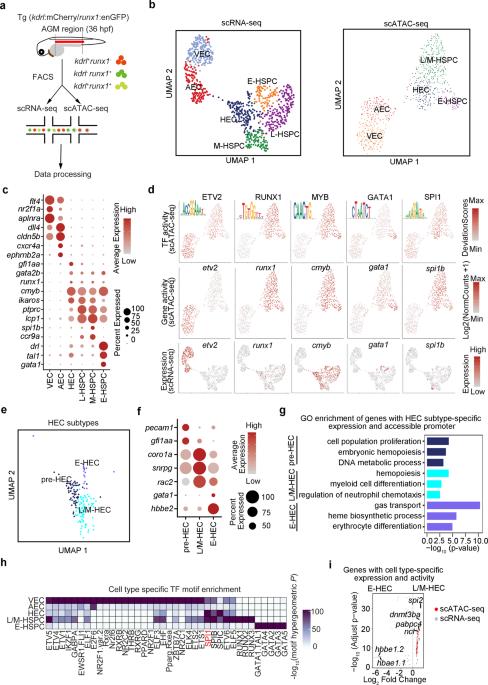在造血干细胞异质性形成之前激活造血内皮的系系能力
IF 28.1
1区 生物学
Q1 CELL BIOLOGY
引用次数: 5
摘要
造血干细胞和祖细胞(HSPCs)被认为是一个异质性群体,但HSPC异质性产生的确切时间、地点和方式在很大程度上仍不清楚。在这里,我们结合使用单细胞多组学、系谱追踪和功能测定,证明了胚胎 HSPCs 起源于斑马鱼胚胎发育过程中的异质性造血内皮细胞(HECs)。单细胞转录组和染色质可及性综合分析表明了转录异质性和调控程序,这些程序在 HEC 水平上为淋巴细胞/骨髓细胞的命运奠定了基础。重要的是,spi2+ HECs 能产生淋巴/髓系催化的 HSPCs(L/M-HSPCs),并在急性炎症下显示出应激反应功能。此外, 我们还发现,Spi2 是通过严格控制内皮细胞向造血过渡程序形成 L/M-HSPCs 所必需的。最后,斑马鱼和人类HECs的单细胞 转录比较以及基于人类诱导多能干细胞的造血分化 结果支持了L/M-HECs的进化保护以及SPI1(哺乳动物中的spi2同源物)在人类中的保守作用。这些结果揭示了HSPC异质性的系源、生物学功能和分子决定因素,为体外诱导可移植的系源HSPC新策略奠定了基础。本文章由计算机程序翻译,如有差异,请以英文原文为准。

Activation of lineage competence in hemogenic endothelium precedes the formation of hematopoietic stem cell heterogeneity
Hematopoietic stem and progenitor cells (HSPCs) are considered as a heterogeneous population, but precisely when, where and how HSPC heterogeneity arises remain largely unclear. Here, using a combination of single-cell multi-omics, lineage tracing and functional assays, we show that embryonic HSPCs originate from heterogeneous hemogenic endothelial cells (HECs) during zebrafish embryogenesis. Integrated single-cell transcriptome and chromatin accessibility analysis demonstrates transcriptional heterogeneity and regulatory programs that prime lymphoid/myeloid fates at the HEC level. Importantly, spi2+ HECs give rise to lymphoid/myeloid-primed HSPCs (L/M-HSPCs) and display a stress-responsive function under acute inflammation. Moreover, we uncover that Spi2 is required for the formation of L/M-HSPCs through tightly controlling the endothelial-to-hematopoietic transition program. Finally, single-cell transcriptional comparison of zebrafish and human HECs and human induced pluripotent stem cell-based hematopoietic differentiation results support the evolutionary conservation of L/M-HECs and a conserved role of SPI1 (spi2 homolog in mammals) in humans. These results unveil the lineage origin, biological function and molecular determinant of HSPC heterogeneity and lay the foundation for new strategies for induction of transplantable lineage-primed HSPCs in vitro.
求助全文
通过发布文献求助,成功后即可免费获取论文全文。
去求助
来源期刊

Cell Research
生物-细胞生物学
CiteScore
53.90
自引率
0.70%
发文量
2420
审稿时长
2.3 months
期刊介绍:
Cell Research (CR) is an international journal published by Springer Nature in partnership with the Center for Excellence in Molecular Cell Science, Chinese Academy of Sciences (CAS). It focuses on publishing original research articles and reviews in various areas of life sciences, particularly those related to molecular and cell biology. The journal covers a broad range of topics including cell growth, differentiation, and apoptosis; signal transduction; stem cell biology and development; chromatin, epigenetics, and transcription; RNA biology; structural and molecular biology; cancer biology and metabolism; immunity and molecular pathogenesis; molecular and cellular neuroscience; plant molecular and cell biology; and omics, system biology, and synthetic biology. CR is recognized as China's best international journal in life sciences and is part of Springer Nature's prestigious family of Molecular Cell Biology journals.
 求助内容:
求助内容: 应助结果提醒方式:
应助结果提醒方式:


